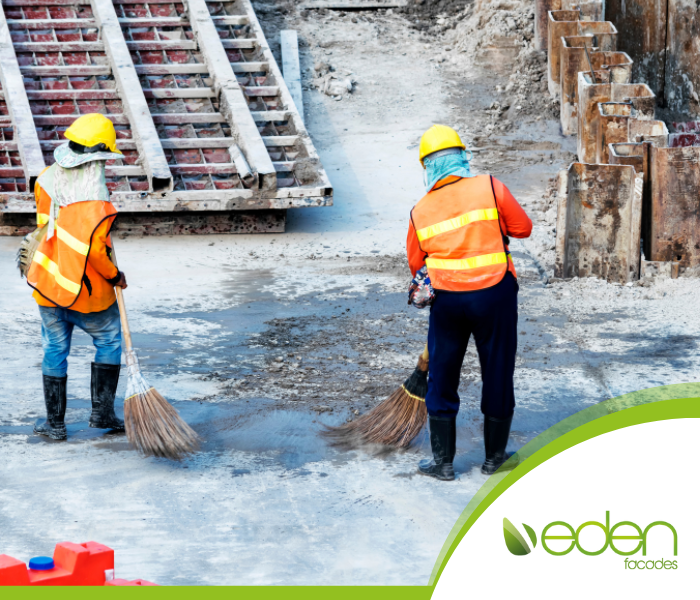Construction presents its own share of difficulties, and adverse weather conditions are no exception.
From the scorching heat of summer, to the biting cold of winter, to the unpredictability of rain and wind, the elements can severely jeopardise the progress of a project, and the safety of personnel.
This article presents practical recommendations on how to counter these challenges, providing a range of measures to maintain efficiency and protect workers on site.
Cold spells: Chill out and stay safe
Brrrr! We think cold weather should be consigned solely to the front of festive postcards. The weather, however, has other ideas, so we need effective planning for worker safety in winter. This includes equipping workers with appropriate clothing, such as layers for insulation, warm socks, and steel-toe capped boots suitable for cold conditions.
Regular breaks in a warm environment and access to hot drinks are crucial to prevent cold stress. A dedicated area for drying wet clothing also helps maintain body temperature and comfort.
It goes without saying that Personal Protective Equipment (PPE) is essential in cold weather, including insulated boots, gloves, and clothing. The chosen PPE should balance warmth with functionality and safety, especially in terms of dexterity and compatibility with machinery.
Environmental hazards like ice, frost, and snow also need addressing to ensure worker safety. Proactive measures like monitoring weather forecasts, preparing de-icing materials such as grit and salt, and maintaining clear, safe walkways are necessary.
Regarding legal regulations, UK law requires employers to assess risks associated with cold weather and provide suitable PPE. The Personal Protective Equipment at Work Regulations 1992 and the Management of Health and Safety at Work Regulations 1999 guide these assessments and provisions.
Windy conditions: Safety is a breeze
On a construction site, high winds can be more than just a bit of a nuisance. They are a serious hazard. You need to hold on to your hard hats and learn how to stay safe when the wind decides to play rough.
Our team secures loose materials to prevent them from becoming dangerous projectiles. This includes anchoring building materials, using weighted anchors, and ensuring the stability of scaffolding. Special attention is needed for lightweight items like roofing materials, as advised by NBS.
Working at heights during windy conditions should be minimised as it’s obviously a huge risk. The Wilkins Safety Group suggests avoiding tasks like working on scaffolding or roofs when winds are strong. If unavoidable, use safety measures like harnesses and stable work platforms.
Safety harnesses are critical for any necessary work at heights in windy conditions. Workers should be trained in using harnesses correctly and how to remain safe if they lose balance.
Storing tools and materials safely is crucial to prevent them from being blown away. We recommend securing boxes, tying down materials, and covering them with netting or tarps. Special care is needed for larger materials that can act like sails.
Hot weather: Sizzle safely
In construction, working in hot weather requires caution; our supervisors always encourage workers to wear light, loose-fitting clothing and to stay hydrated on all projects we work on. That’s fundamental. It’s a simple measure that assists in maintaining body temperature and prevents dehydration.
Try to offer flexible working patterns as this allows workers to avoid the hottest parts of the day. If they could start earlier or finish later, that might minimise exposure to peak temperatures.
Careful in all conditions
At Eden Facades we cultivate a culture and ethos focused on safety, especially in adverse weather conditions. Safety is a commitment ingrained in our operational practices and a cornerstone of our reputation.
Terry Box, SHEQ Manager at Eden Facades, comments:
“One of the key aspects of our approach is the emphasis on ‘toolbox talks’ at the beginning of each project. These talks are comprehensive sessions where site workers are brought up to speed with the latest safety precautions and measures. We really have to make sure that every team member is aware of potential hazards and knows how to tackle them safely, particularly in challenging weather conditions.”
Dealing with adverse weather conditions through thorough preparation, continuous education, dedicated management, and a strong sense of communal responsibility provides a strong framework for safety and efficiency, even under challenging conditions.
Speak to us today about recent rainscreen cladding projects we’ve worked on, and how we can fulfil your facade and cladding needs, whatever the weather.

